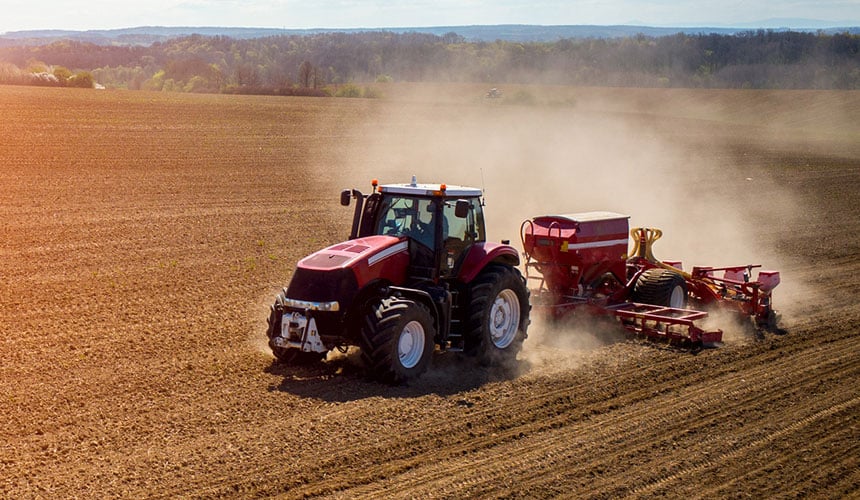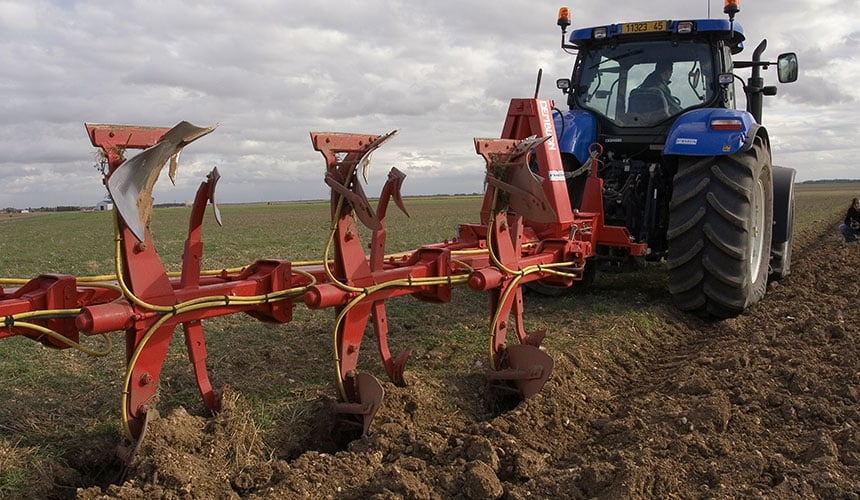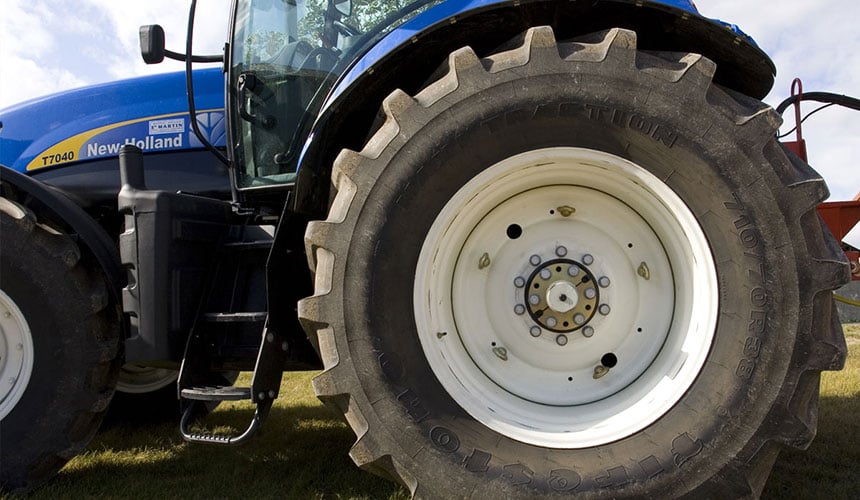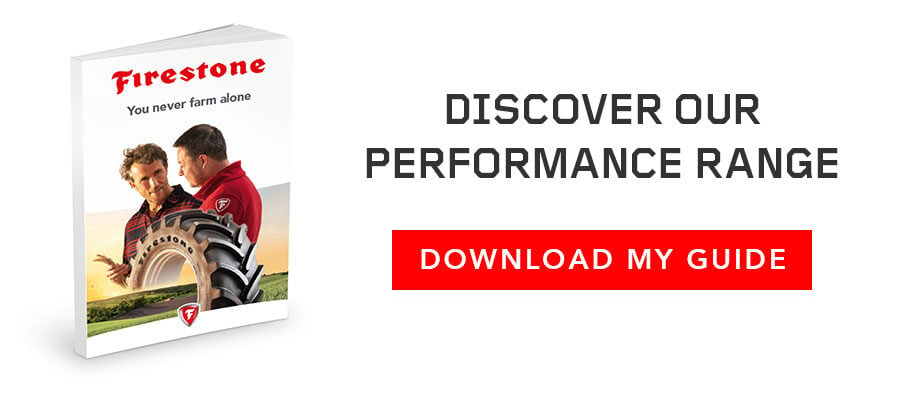You have invested in your tractor to have engine power, which brings productivity, rapidity and longevity. However, without optimal management of your tyres you will have trouble transmitting this power to the ground to transform it into tractive force.
Depending on your pressure settings, the size of your tyres, your tyre technology or the general set-up of your tractor, you can increase your traction capacity considerably and save precious time, above all if you travel from one site to another working on different campaigns.
If you wish to improve your vehicle’s traction, the choice of tyre is crucial. The tyre’s principal role is effectively to transmit the tractor’s power to the ground. The tyre is actually the sole element connecting ground to machine.
By opting for tyres that are perfectly adapted to your tractor, your implements, your type of soil or your activity, you can obtain the best possible traction and therefore improve your performances.
If you regularly transport heavy loads or work with very large implements, you must use tyres whose dimensions correspond to your implements, so as to obtain a better distribution of load and pressure to the ground. You obtain optimal traction when the tyre takes hold on the ground without sinking in due to the load.
Here is some detailed advice on how to improve traction and save time:
1. Adopt the right tyre size based on load to improve efficiency
If your implements are heavy and your tractor is equipped with standard size tyres, you will be obliged to compensate for the load by increasing inflation pressure to bear the weight of your implements.
Unfortunately, this option is not without consequences, because standard tyres sink further into the ground, in particular when the soil is damp or soft. These working conditions increase rolling resistance and slip, thus reducing your traction capacity.
Tyre dimensions that are not adapted to your implements can increase rolling resistance
It’s the quantity of air in the tyre that compensates for the weight of your implements. If your tyre is too small, you have to increase inflation pressure to resist the load and the tyre will sink deeper into the ground before it meets resistance.
Rolling resistance is exactly what happens when the tractor tyre sinks into the ground. It corresponds to the force necessary to keep the tyre moving at regular speed, getting past the quantity of earth in front of the tyre which the tyre has to pass over continually to move forward.
Rolling resistance depends principally on the following factors:
- The axle load,
- The tyre width,
- The volume of air in the tyre,
- The inflation pressure,
- The tyre structure: diagonal, radial,
- The tyre’s technological level: standard, IF, VF
The higher the rolling resistance, the more energy you need to make the tyre move forwards. Rolling resistance can slow down the trailer when it sinks into soft ground. This phenomenon is accentuated when the trailed implement also creates resistance to traction.
Obviously, the more the implement is under strain, the greater the resistance to moving forward.
Tyre dimensions that are not adapted to your implements lead to more slip
Slip increases due to certain factors:
- Weather conditions,
- Tyre technology,
- Inflation pressure,
- Tyre design.
A minimum amount of slip is necessary for your tractor to move forwards. However, it must be perfectly controlled to avoid any major loss of power.
Excessive slip means that additional tractive force is necessary, resulting in more fuel consumption. Your tyres are also likely to suffer from premature wear.
 Wide tyres allow you to save time
Wide tyres allow you to save time
To compensate for these problems with rolling resistance or slip and to obtain optimal traction, increasing the size of your wheels based on load is a very worthwhile solution.
The wider the tyre section, the less the tyre sinks into the ground. You just need to move up to a series 75, 70, 65 or even 60 tyre to obtain a larger soil footprint.
A wider tyre gives you a greater volume of air, leading to better grip on the ground. You will optimise traction, which will allow you to save a great deal of time by the end of each working day.
2. Better pressure management to optimise traction
Working with overinflated tyres, especially on wet or soft ground, inevitably leads to a high slip ratio, which increases the tractive force necessary to pull the tractor forwards. This has a direct impact on working time as well as on fuel consumption.
Good agricultural tyre pressure management is an effective way of optimising traction. There is indeed a direct link between tyre pressure settings and your tractor’s tractive capacity.
Using average inflation pressure to make life simpler is really not the solution, given that a slight difference of 0.25 bar can reduce slip and save an enormous amount of time.
When you work at low pressure in the fields, the contact patch with the ground increases, giving you better motricity. And like when you opt for larger tyres, the lugs have a better grip on the ground, which improves the tractive force considerably.
3. What tyre technology helps you save time?
The tractor’s original tyres are not necessarily the best for your farm. It is therefore worthwhile replacing them with an innovative, high-performance design.
You can opt for large low-pressure IF tyres to spread the pressure and traction capacity better over a larger contact patch with the ground.
As their name indicates, IF (Improved Flexion) tyres have a greater flexion capacity in their sidewalls than standard tyres. Their design, which is the fruit of research and development work, has resulted in a casing that is reinforced and supple at the same time, made using special, highly resistant materials.
These new generation tyres are versatile and adapt perfectly to different uses. They can carry an extra load of 20% more than standard agricultural tyres.
 FIRESTONE’s Maxi Traction IF tyres
FIRESTONE’s Maxi Traction IF tyres
In addition, IF technology agricultural tyres have optimised lugs with a structure designed specifically to improve self-cleaning. As opposed to classical lugs which produce a soil displacement effect, lifting up the earth during the tyre rotation, IF tyre lugs have a profile with a very specific angle which ensures maximum self-cleaning of the surface of the tyre before it comes back into contact with the ground.
Thanks to their specific lug design, IF tyres effectively reduce slip while increasing the transmission of horizontal tractive force and save on production time.
Among the best models on the market, Firestone’s Maxi Traction IF tyre was designed to work at low pressure, given that this technology means that you no longer have to adapt pressure between road and field.
The time saved is considerable, because you no longer have to get down from the cab to change inflation pressure when travelling between the fields and the road.
4. Conclusion: Good management of agricultural tyres leads to real time saving on a daily basis
As we have seen in the different sections of this article, there are several factors which make it possible to:
- increase traction,
- reduce pressure,
- and avoid having to make pressure adjustments between the road and the fields.
It’s the combination of the three points which will provide the solution to optimal time saving.
If, when it’s time to replace your tyres, you opt for large dimension, high air volume tyres, you choose IF technology tyres that allow you to work at low pressure and you carry out check-ups and adapt pressure regularly, you can be sure to work in the best possible conditions at all times.
You will then really reduce slip and considerably improve the transmission of power to the ground, because the rolling surface in contact with the ground is larger.
 IF tyre with a high volume of air
IF tyre with a high volume of air
Low pressure combined with large size tyres also gives you optimal load distribution to the ground, with less pressure to limit compaction. Lastly, this technique allows you to reduce fuel consumption and increase productivity, which in the end represents a highly beneficial and economic optimisation of your agricultural equipment.
For more information on tractor tyres
With Firestone, you have the guarantee of tractor tyres that deliver a real advantage, and that in choosing our brand, you can work worry-free.

Most people who read this article have also read some of the following articles:
This information is intended only to make you aware of the technical and functional aspects of agricultural tires and their use. It does not allow you to make a judgment or a definitive conclusion on a given problem. Only your agricultural tire expert is able to make a technical assessment and take a final decision, case by case.